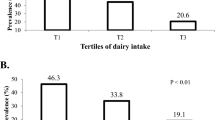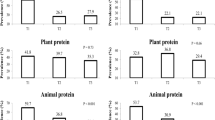Abstract
Background:
There is a need for biomarkers of dietary saturated fatty acids, because several diseases have been related to intake of these fatty acids.
Objective:
To examine the relation between intake of dairy fat and the proportion of pentadecanoic (15:0) and heptadecanoic (17:0) acid in serum and adipose tissue.
Design:
Healthy men aged 21–55 y provided serum (n=110) and adipose tissue samples (n=107) and completed both 14 days weighed records (WR) and a 180-item food frequency questionnaire (FFQ). The proportions of 15:0 and 17:0 acid in serum and adipose tissue as measured by gas liquid chromatography were evaluated as biomarkers for fat intake from dairy products using Pearsons correlation coefficient and the method of triads.
Results:
The strongest correlation coefficients were observed between total intake of dairy fat estimated from WR and relative content of 15:0 in adipose tissue (0.52, 95% CI: 0.37, 0.65) and total serum (0.43, 95% CI 0.26, 0.57). A consistent inverse association was observed between the intake of milk fat and relative serum content of 17:0. The validity coefficients observed for the intake of dairy fat estimated from weighed records, the 180-item FFQ and by the relative content of 15:0 in serum and adipose tissue were 0.94 (95% CI: 0.68, 1.00), 0.50 (95% CI: 0.29, 0.67), 0.49 (95% CI: 0.32, 0.67) and 0.56 (95% CI: 0.28, 0.82), respectively.
Conclusion:
Relative content of 15:0 in serum and adipose tissue may be a useful biomarker for the intake of total dairy fat, whereas FFQs and WRs may provide better estimates of the intake of fat from milk.
This is a preview of subscription content, access via your institution
Access options
Subscribe to this journal
Receive 12 print issues and online access
$259.00 per year
only $21.58 per issue
Buy this article
- Purchase on Springer Link
- Instant access to full article PDF
Prices may be subject to local taxes which are calculated during checkout
Similar content being viewed by others
References
Andersen LF, Solvoll K, Johansson LR, Salminen I, Aro A & Drevon CA (1999): Evaluation of a food frequency questionnaire with weighed records, fatty acids, and alpha-tocopherol in adipose tissue and serum. Am. J. Epidemiol. 150, 75–87.
Andersson A, Nalsen C, Tengblad S & Vessby B (2002): Fatty acid composition of skeletal muscle reflects dietary fat composition in humans. Am. J. Clin. Nutr. 76, 1222–1229.
Artaud-Wild SM, Connor SL, Sexton G & Connor WE (1993): Differences in coronary mortality can be explained by differences in cholesterol and saturated fat intakes in 40 countries but not in France and Finland. A paradox. Circulation 88, 2771–2779.
Baylin A, Kabagambe EK, Siles X & Campos H (2002): Adipose tissue biomarkers of fatty acid intake. Am. J. Clin. Nutr. 76, 750–757.
Bingham SA, Gill C, Welch A, Cassidy A, Runswick SA, Oakes S, Lubin R, Thurnham DI, Key TJ, Roe L, Khaw KT & Day NE (1997): Validation of dietary assessment methods in the UK arm of EPIC using weighed records, and 24-h urinary nitrogen and potassium and serum vitamin C and carotenoids as biomarkers. Int. J. Epidemiol. 26 (Suppl 1), S137–S151.
Daures JP, Gerber M, Scali J, Astre C, Bonifacj C & Kaaks R (2000): Validation of a food-frequency questionnaire using multiple-day records and biochemical markers: application of the triads method. J. Epidemiol. Biostat. 5, 109–115.
Folch J, Lees M & Statkute L (1957): A simple metod for the isolation and purification of total lipids from animal. J. Biol. Chem. 226, 497–507.
Grant WB (1998): Milk and other dietary influences on coronary heart disease. Altern. Med. Rev. 3, 281–294.
Hara A & Radin N (1978): Lipid extraction of tissue with low-toxicity solvent. Anal. Biochem. 90, 420–426.
Kaaks RJ (1997): Biochemical markers as additional measurements in studies of the accuracy of dietary questionnaire measurements: conceptual issues. Am. J. Clin. Nutr. 65 (4 Suppl), 1232S–1239S.
Kaaks R & Riboli E (1997): Validation and calibration of dietary intake measurements in the EPIC project: methodological considerations. European Prospective Investigation into Cancer and Nutrition. Int. J. Epidemiol. 26 (Suppl 1), S15–S25.
Kabagambe EK, Baylin A, Allan DA, Siles X, Spiegelman D & Campos H (2001): Application of the method of triads to evaluate the performance of food frequency questionnaires and biomarkers as indicators of long-term dietary intake. Am. J. Epidemiol. 154, 1126–1135.
Kromhout D, Menotti A, Bloemberg B, Aravanis C, Blackburn H, Buzina R, Dontas AS, Fidanza F, Giampaoli S & Jansen A (1995): Dietary saturated and trans fatty acids and cholesterol and 25-year mortality from coronary heart disease: the Seven Countries Study. Prev. Med. 24, 308–315.
Laugesen M & Elliott R (2003): Ischaemic heart disease, type 1 diabetes, and cow milk A1 beta-casein. N. Z. Med. J. 116, U295.
Merkel M, Velez-Carrasco W, Hudgins LC & Breslow JL (2001): Compared with saturated fatty acids, dietary monounsaturated fatty acids and carbohydrates increase atherosclerosis and VLDL cholesterol levels in LDL receptor-deficient, but not apolipoprotein E-deficient, mice. Proc. Natl. Acad. Sci. USA 98, 13294–13299.
Moilanen T, Rasanen L, Viikari J, Akerblom HK & Nikkari T (1992): Tracking of serum fatty acid composition: a 6-year follow-up study in Finnish youths. Am. J. Epidemiol. 136, 1487–1492.
Moss M & Freed D (2003): The cow and the coronary: epidemiology, biochemistry and immunology. Int. J. Cardiol. 87, 203–216.
Nes M, Frost AL, Solvoll K, Sandstad B, Hustvedt BE, Lovo A & Drevon CA (1992): Accuracy of a quantitative food frequency questionnaire applied in elderly Norwegian women. Eur. J. Clin. Nutr. 46, 809–821.
Nicolosi RJ, Wilson TA, Lawton C & Handelman GJ (2001): Dietary effects on cardiovascular disease risk factors: beyond saturated fatty acids and cholesterol. J. Am. Coll. Nutr. 20 (5 Suppl), 421S–427S.
Nikkari T, Luukkainen P, Pietinen P & Puska P (1995): Fatty acid composition of serum lipid fractions in relation to gender and quality of dietary fat. Ann. Med. 27, 491–498.
Ocke MC & Kaaks RJ (1997): Biochemical markers as additional measurements in dietary validity studies: application of the method of triads with examples from the European Prospective Investigation into Cancer and Nutrition. Am. J. Clin. Nutr. 65 (4 Suppl), 1240S–1245S.
Ocke MC, Bueno-de-Mesquita HB, Pols MA, Smit HA, van Staveren WA & Kromhout D (1997): The Dutch EPIC food frequency questionnaire. II. Relative validity and reproducibility for nutrients. Int. J. Epidemiol. 26 (Suppl 1), S49–S58.
Pedersen JI, Kirkhus B & Muller H (2003): Serum cholesterol predictive equations in product development. Eur. J. Med. Res. 8, 325–331.
Ravnskov U (1998): The questionable role of saturated and polyunsaturated fatty acids in cardiovascular disease. J. Clin. Epidemiol. 51, 443–460.
Renaud S & de Lorgeril M (1989): Dietary lipids and their relation to ischaemic heart disease: from epidemiology to prevention. J. Intern. Med. Suppl. 225, 39–46.
Rimestad AH, Borgejordet Å, Vesterhus KN, Sygnestveit K, Løken EB, Trygg K, Pollestad ML, Lund-Larsen K & Omholt-Jensen G (2001): Den store matvaretabellen/The Norwegian Food Table. Oslo, Statens råd for ernæring og fysisk aktivitet, Statens næringsmiddeltilsyn, Institutt for ernæringsforskning.
Samuelson G, Bratteby LE, Mohsen R & Vessby B (2001): Dietary fat intake in healthy adolescents: inverse relationships between the estimated intake of saturated fatty acids and serum cholesterol. Br. J. Nutr. 85, 333–341.
Schneeman BO, Rice R & Richter BD (1989): Reduction of plasma and hepatic triacylglycerides with whole milk-containing diets in rats. J. Nutr. 119, 965–970.
Seely S (1981): Diet and coronary disease: a survey of mortality rates and food consumption statistics of 24 countries. Med. Hypotheses 7, 907–918.
Segall JJ (1994): Dietary lactose as a possible risk factor for ischaemic heart disease: review of epidemiology. Int. J. Cardiol. 46, 197–207.
Smedman AE, Gustafsson IB, Berglund LG & Vessby BO (1999): Pentadecanoic acid in serum as a marker for intake of milk fat: relations between intake of milk fat and metabolic risk factors. Am. J. Clin. Nutr. 69, 22–29.
Solvoll K (2000): Development, evaluation and application of quantitative food frequency questionnaire for assessment of dietary habits. PhD Thesis, Institute for Nutrition Research, Faculty of Medicine, University of Oslo.
Stoffel W, Chu F & Ahrens E (1959): Analysis of long-chain fatty acids by gas chromatography. Anal. Chem. 31, 307–308.
Tholstrup T, Hoy CE, Andersen LN, Christensen RD & Sandstrom B (2004): Does fat in milk, butter and cheese affect blood lipids and cholesterol differently? J. Am. Coll. Nutr. 23, 169–176.
van Poppel G, Van Erp-Baart MA, Leth T, Gevers E, Van Amelsvoort J, Lanzmann-Petithory D, Kafatos A & Aro A (1998): Trans fatty acids in foods in Europe: The Transfair Study. J. Food Compos. Anal. 11, 112–136.
Warensjo E, Jansson JH, Berglund L, Boman K, Ahren B, Weinehall L, Lindahl B, Hallmans G & Vessby B (2004): Estimated intake of milk fat is negatively associated with cardiovascular risk factors and does not increase the risk of a first acute myocardial infarction. A prospective case–control study. Br. J. Nutr. 91, 635–642.
Willett WC (2003): Diet and coronary heart disease. In Nutritional Epidemiology, ed. WC Willett, pp 414–446. New York: Oxford University Press.
Wolk A, Vessby B, Ljung H & Barrefors P (1998): Evaluation of a biological marker of dairy fat intake. Am. J. Clin. Nutr. 68, 291–295.
Wolk A, Furuheim M & Vessby B (2001): Fatty acid composition of adipose tissue and serum lipids are valid biological markers of dairy fat intake in men. J. Nutr. 131, 828–833.
Yu S, Derr J, Etherton TD & Kris-Etherton PM (1995): Plasma cholesterol-predictive equations demonstrate that stearic acid is neutral and monounsaturated fatty acids are hypocholesterolemic. Am. J. Clin. Nutr. 61, 1129–1139.
Acknowledgements
We are indebted to Birgit Roaas and the rest of the medical staff at Oerland Flight station. We thank Anne Randi Alvestad, Eva Grabner, Kari Solvoll and Thomas Gundersen from The Department of Nutrition Research, and Torill Rode from Institute of Aviation Medicine for expert technical assistance. The project was funded in part by the Norwegian Research Council, the National Council on Nutrition and Physical Activity and the Ministry of Health and Social Affairs.
Author information
Authors and Affiliations
Corresponding author
Additional information
Guarantor: LF Andersen.
Contributors: AB did the data analysis and the writing. MBV calculated the confidence intervals. LFA and CAD took part in the planning, provided consultation on the interpretation of the results and commented on the final version of the manuscript.
Rights and permissions
About this article
Cite this article
Brevik, A., Veierød, M., Drevon, C. et al. Evaluation of the odd fatty acids 15:0 and 17:0 in serum and adipose tissue as markers of intake of milk and dairy fat. Eur J Clin Nutr 59, 1417–1422 (2005). https://doi.org/10.1038/sj.ejcn.1602256
Received:
Revised:
Accepted:
Published:
Issue Date:
DOI: https://doi.org/10.1038/sj.ejcn.1602256
Keywords
This article is cited by
-
Interaction between plasma phospholipid odd-chain fatty acids and GAD65 autoantibodies on the incidence of adult-onset diabetes: the EPIC-InterAct case–cohort study
Diabetologia (2023)
-
Circulating short and medium chain fatty acids are associated with normoalbuminuria in type 1 diabetes of long duration
Scientific Reports (2021)
-
Circulating fatty acids and endocannabinoidome-related mediator profiles associated to human longevity
GeroScience (2021)
-
Efficacy of dietary odd-chain saturated fatty acid pentadecanoic acid parallels broad associated health benefits in humans: could it be essential?
Scientific Reports (2020)
-
Untargeted lipidomics using liquid chromatography-ion mobility-mass spectrometry reveals novel triacylglycerides in human milk
Scientific Reports (2020)



